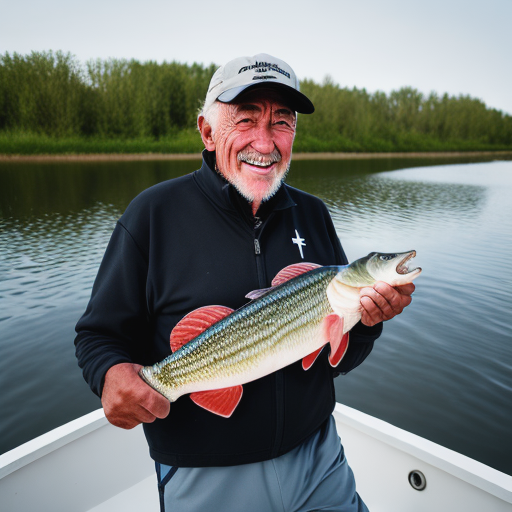Fly casting is a key skill for a great fly fishing trip. It’s important for both new and experienced anglers. Mastering roll casting in the wind is key to success.
Wind can really mess with your fly line, making precise casts hard. Roll casting tackles this problem. With practice, you can get your fly right to the fish, even in strong winds.
Key Takeaways:
- Learning roll casting is crucial for fly fishing in the wind.
- It lets you make accurate casts without a backcast.
- Knowing different fly casts and when to use them is important.
- Working on your timing, rhythm, and smoothness will make you better at roll casting.
- Changing your casting style for the wind or water conditions can help a lot.
Why Mastering Roll Casting Techniques Matter
Fly fishing in windy conditions? Mastering roll casting is key. It lets you cast accurately without a backcast. Roll casting helps you fight the wind, improving your fishing trips.
Roll casting boosts your accuracy. In the wind, regular casts may not work well, making your fly go off target. But with roll casting, you work with the water’s surface to aim better and not scare the fish.
Plus, it makes your fly land softly. This is great for tricky fish or when the water is clear. Roll casting’s gentle touch can attract even the pickiest fish.
Roll casting is your secret weapon in the wind. It amps up your fishing game and outsmarts the conditions.
Roll casting also makes your fishing trips more fun and effective. Windy days won’t tire you out as much with this skill. You’ll spend more time enjoying fishing and less fighting the wind.
Roll Casting Tips
Here are some crucial tips for roll casting:
- Work on your timing and keep your cast smooth for better control.
- Adjust your rod angle for the wind and to cast better.
- Try a heavier fly line for windy days to cast further and straighter.
- Manage your line well to cast smoothly and avoid tangles.
- Getting advice from pros or taking lessons can really up your roll casting game.
With practice, you’ll roll cast like a pro. Windy days will turn into great fishing adventures. So, grab your rod, face the wind, and aim to be a roll casting expert!
After mastering roll casting, fly fishing offers even more to learn. Next, check out different fly casts and how they fit various fishing plans.
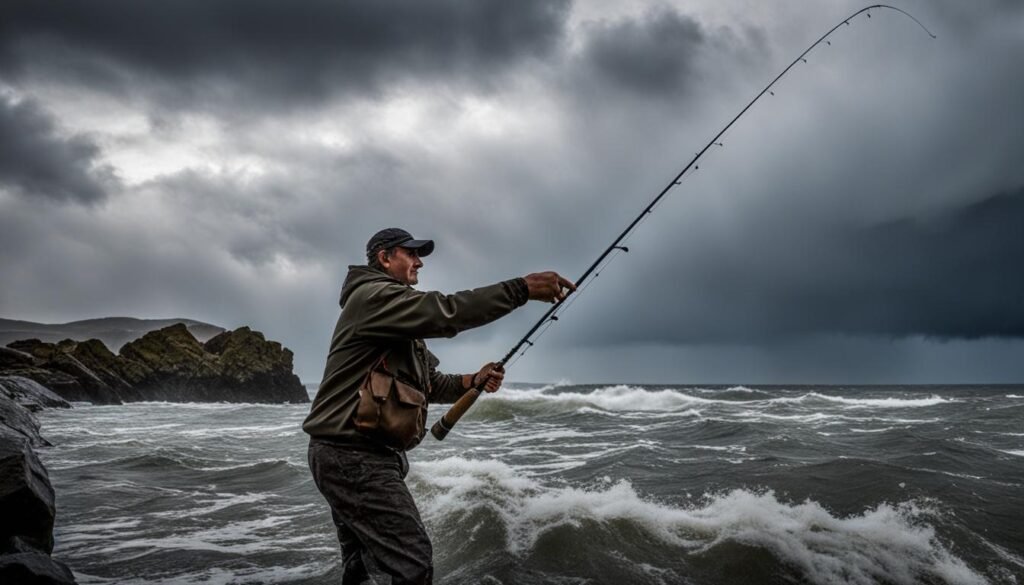
Understanding the Types of Fly Casts
Fly fishing needs you to know different casts for success. Each type aids in various fishing situations. We will look at overhead, false, roll, and tuck casts.
The Overhead Cast
The overhead cast is very common and versatile. It swings the line back and forth for power. This cast is great for open spaces and when you need to cast far.
The False Cast
The false cast is for changing direction or drying a fly. It tosses the line in the air to make adjustments. Anglers use it to aim better, add line, or dry their fly.
The Roll Cast
The roll cast doesn’t need a big space behind. It’s perfect in tight spots, forming a loop on the water. This cast is good for small streams and windy days.
The Tuck Cast
The tuck cast presents flies quietly and accurately. It’s for catching cautious fish. Use it in deep water or to look natural to fish.
| Type of Fly Cast | Purpose | Best Fishing Scenarios |
|---|---|---|
| Overhead Cast | Long and accurate casts | Ample space, distance is a priority |
| False Cast | Change direction, adjust aim, add more line, dry flies | Changing fishing conditions, waterlogged flies |
| Roll Cast | Casting without a backcast, tight spaces, windy conditions | Confined areas, obstacles behind the angler, windy days |
| Tuck Cast | Precise and accurate presentations | Targeting finicky fish, mimicking natural presentations |
Learning these casts makes you better at fishing. Practice to get good at each one. This way, you’ll be ready for all fishing situations.

Mastering the Timing and Rhythm
Timing and rhythm are very important in a good fly cast. By moving in sync with a steady beat, you can cast farther and more accurately. The perfect timing helps your line unfurl just right, sending your fly where you want it with skill.
Think of casting as a dance. Each step should flow smoothly into the next. Initially, move your rod slowly back, then pick up speed. Pause at the top briefly to let the line straighten behind you.
“Timing is everything in fly casting. It’s like conducting an orchestra, where each movement must be in harmony with the next to create a beautiful symphony.” – John Norris, Fly Fishing Expert
After the brief pause, perform the forward cast smoothly with a release of energy. The path of the forward cast should mirror the backcast. Keeping a steady rhythm is crucial. This helps the rod and line move efficiently.
Finding the Rhythm
Creating a steady rhythm is key to a great cast. The rhythm connects you, your rod, and the line. With the right rhythm, your casts will feel smooth and easy.
Casting to a beat is a good way to find your rhythm. Imagine a drum playing or your favorite song in the background. Let the beat guide your actions to set a regular pace.
Practice is essential for improving timing and rhythm. Doing casting exercises regularly will make your body remember the movements. Paying attention to timing and embracing the rhythm makes casting better. You’ll cast further and more accurately effortlessly.

Adapting to Different Weather and Water Conditions
In fly fishing, knowing how to deal with different weather and water is key. The wind and water can change how you cast and fish. By tweaking your cast, you can master these obstacles.
Facing windy days, control your line and fly is a must. Wind can mess with your aim and how well you present your fly. Aim lower, close to the water, with a tight cast to beat the wind dance.
For changing waters, your casting must change too. In calm spots, soft and gentle casts work best. In swift rivers, go strong against the current. On still lakes, even the tiniest wave can scare off fish. Aim precisely.
Learn to change your cast for different conditions to succeed in fly fishing. With enough practice, you can quickly adapt and improve your odds of catching the big one.
Fly Casting Techniques for Different Wind Conditions
Here are tips for casting in various wind:
- Feel the wind’s direction. A wind at your back can help your cast fly farther. But, a headwind means you need to adjust. Use the wind’s force to land your fly right.
- Wind changes when to cast. You might need to throw your fly earlier against the wind. More power ensures your fly reaches where you aim despite the wind.
- Pick flies that handle the wind well. Heavier, aerodynamic flies like streamers work better on breezy days. They help keep your line under control.
Adapting Casting Technique to Water Conditions
For water conditions, try these approaches:
- Calm waters need a soft approach. Make precise and gentle casts. Let your lure land smoothly.
- In rapid rivers, cast with force. Work with the current by angling your cast rightly.
- On still lakes, be ultra-precise. Aim for exact points without disturbing the water.
Now you know how to change your cast for different weather and water. Practice and try different strategies. Soon, you’ll smoothly handle any fishing setting.

Tools and Equipment for Effective Fly Casting
The right tools for fly casting are crucial for fishing. If you’re experienced or just starting, good fly fishing gear makes a big difference. You need the best fly rods, lines, and flies.
Fly Rods
Your fly rod choice matters a lot. Think about the rod’s weight and type for fishing and the fish you want. For small streams and gentle casts, go with a lighter rod, maybe 3 or 4 weight. For big waters and large fish, pick a heavier rod, like 8 or 9 weight.
Lines
The proper fly line helps with distance and accuracy when casting. Choose from floating lines, sinking lines, and intermediate lines for different fishing needs. Always match the line weight to your rod for the best results.
Flies
It’s important to have many fly patterns. Flies come in lots of sizes, colors, and styles, mimicking different bugs or fish. Make sure your fly box has dry flies, nymphs, streamers, and emergers for all fishing types.
Recommended Fly Fishing Gear
| Item | Features |
|---|---|
| Fly Rod | Choose the best weight and type for where you’re fishing and the fish you want. |
| Fly Line | Use the right line weight and style (floating, sinking, or intermediate) for your rod and casting. |
| Flies | Keep many fly patterns (dry flies, nymphs, streamers, emergers) to look like different bugs or fish. |

Picking the right fly fishing gear, like rods, lines, and flies, is key for a good fishing trip. Think about your fishing spot and the fish you want. Keep a big variety of flies. With the best gear, your fly casting and fish catching will get better.
The Basics of a Roll Cast
The roll cast is key in fly fishing and doesn’t need a backcast. This helps a lot when space is tight behind you. This happens in small streams or around lots of plants.
So, how do you do a roll cast? Here are the steps in a simple way:
- Set your stance: Stand with your feet apart and look at where you want to cast.
- Hold the rod: Use your main hand to hold the rod and your other hand to hold the line. Make sure your arm and wrist are comfortable.
- Form a D-loop: Lift the rod tip a bit. Then, move it back in an arc to make a loop of line behind you, called the D-loop.
- Generate power: As the D-loop forms, the water’s surface tension helps load the rod with energy. This step is unique to the roll cast because you’re not using the line’s weight for this.
- Direct your cast: Now, aim the energy forward towards your target. The line will roll out ahead, showing your fly to fish.
The roll cast is great for casting well in wind. Since it doesn’t need a backcast, you keep your line low. This makes the wind have less effect.
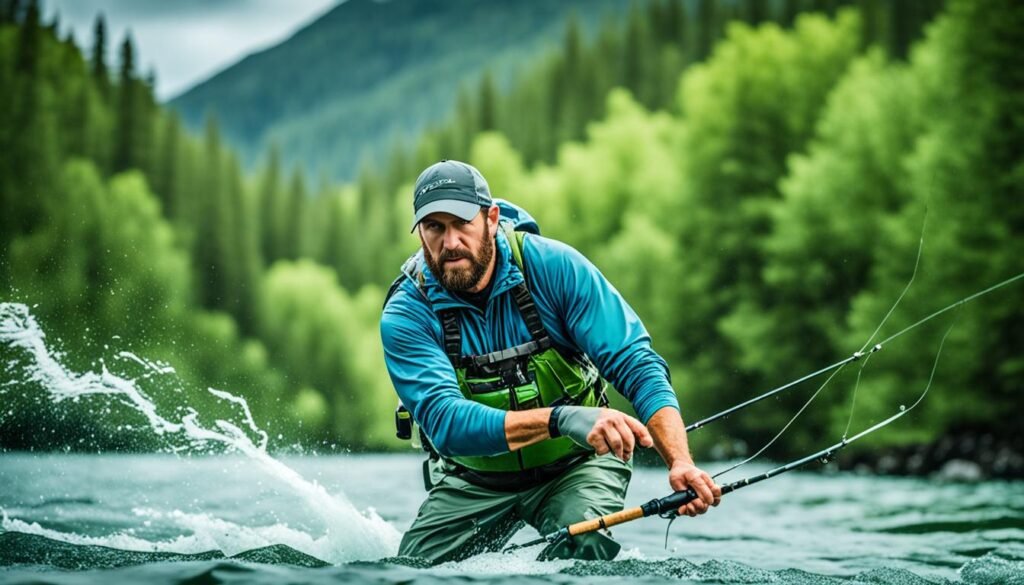
Tips for Refining Your Roll Cast
Improving your roll cast involves smooth moves, perfect timing, and lots of practice. By working on these aspects, your fly fishing skills will get better. This will make your time on the water more enjoyable.
1. Smooth Movements
Successful roll casts start with smooth, controlled actions. Begin by casting slowly, then pick up speed as you let go of the line. Doing this keeps your line loop in shape, making your casts accurate and effective.
2. Perfect Timing
Getting the timing right is vital. You should start the forward stroke as the line straightens behind you. This loads the line with the energy needed for a strong, precise cast. Watch the line to learn its tension and path, improving your timing.
3. Practice Different Angles and Distances
To get better, try different cast angles and lengths. Change the direction and level of your casting to see what works best. Also, cast at various distances to boost accuracy for any fishing situation.
“Refining your roll cast requires honing your technique through consistent practice. Focus on developing smooth, controlled movements and perfecting your timing. With dedicated practice, you’ll see significant improvements in your roll casting ability.” – Expert Fly Angler
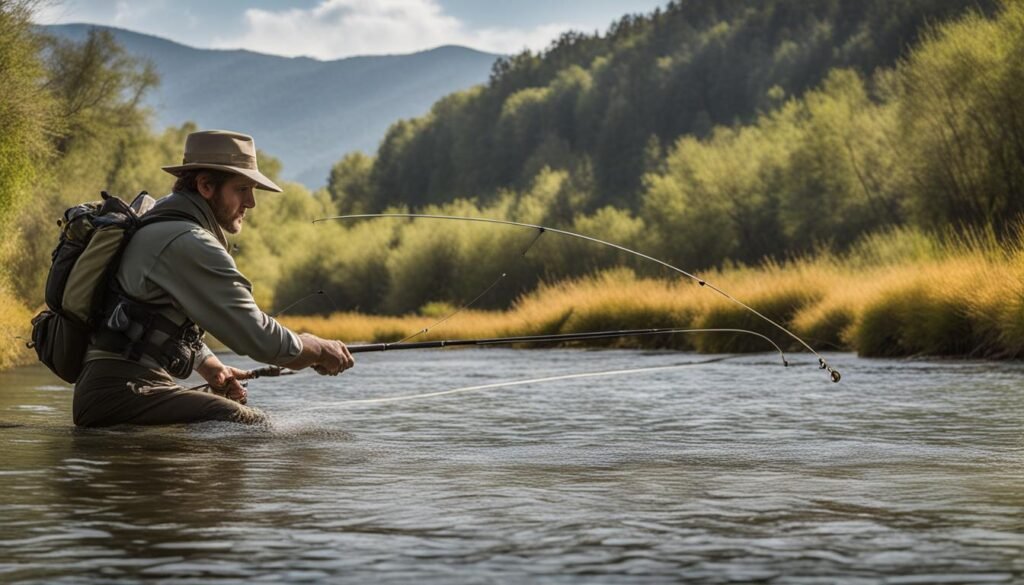
The Benefits of Practice
Practice makes your roll cast perfect. The more you practice, the more your moves will feel like second nature. This muscle memory helps you cast effortlessly, with better accuracy. So, put in the practice time for a polished roll cast.
Don’t forget, becoming great at the roll cast needs time and patience. Keep working on your technique, focusing on smooth moves, great timing, and regular practice. These tips will make you a better, more confident angler in the end.
When to Use a Roll Cast
The roll cast is a great skill for fly fishing in various settings. It’s perfect when you have little room behind you, in windy weather, or surrounded by obstacles. These unique features are what make the roll cast stand out.
When space is tight, the roll cast is the best choice. It needs very little room behind you to work. This means you can fish near trees or bushes without getting caught.
In the wind, casting can be hard, but the roll cast works well. It uses the water’s tension to make precise casts. This reduces how much the wind messes with your line helps get your fly exactly where you want it.
“The roll cast is great in the wind,” says Mark Thompson, a pro angler. “It keeps your casting accurate even when it’s breezy.”
Learning the roll cast is key, offering big benefits in tricky fishing situations. It makes you a better angler. So, take time to practice and improve your roll cast skills.
Additional Applications:
- Casting around overhanging trees and vegetation
- Presenting the fly softly on calm waters
- Navigating narrow streams and streamside brush
Being flexible is important in fly fishing. The roll cast is a skill that makes handling different fishing spots easier. Add it to your casting toolkit.
Keep reading for more tips on perfecting your roll cast, especially in windy weather.
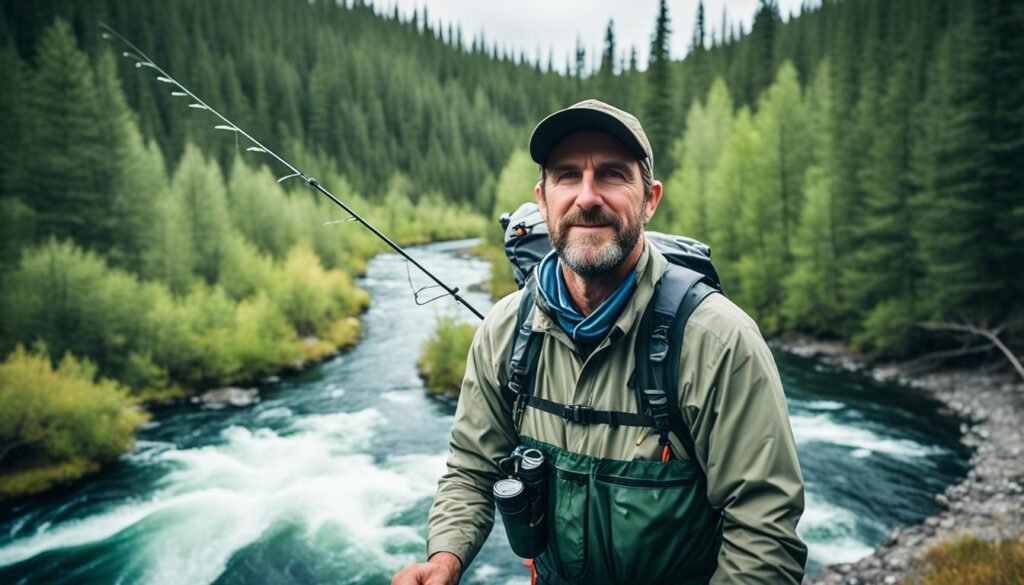
Conclusion
Learning to roll cast under windy conditions is crucial for fly fishing experts. By mastering the basics and fine-tuning your moves, you’ll cast like a pro. This skill lets you face wind and obstacles, making your fishing more successful.
Roll casting is great for when the wind is strong or your space is limited. With practice, your aim will be spot on. This means getting your fly right where you want it.
Getting really good at fly fishing takes hard work and focus. Keep practicing and trying new things to make your fly fishing a true adventure. Even in rough weather, you can still have a great time casting.
FAQ
What is roll casting in fly fishing?
Roll casting is a unique technique in fly fishing. It doesn’t need a backcast. You create a loop and rely on water tension to cast.
When should I use a roll cast?
Use a roll cast when you have little room behind you. It’s great for casting around obstacles or in the wind. This technique helps keep your cast both accurate and controlled.
How can I improve my roll cast?
To get better at roll casting, work on being smooth and in tune with your timing. Try out different angles and distances too. It takes time and practice to get the hang of it.
What gear do I need for effective fly casting?
The right gear is key for successful fly casting. Think about your rod’s weight and type. Also, have an array of flies for different occasions and select an appropriate fly line.
How do I adapt my casting technique to different weather and water conditions?
Changing your casting technique helps with windy or different water situations. With practice, you’ll learn how to adjust for the best results.

